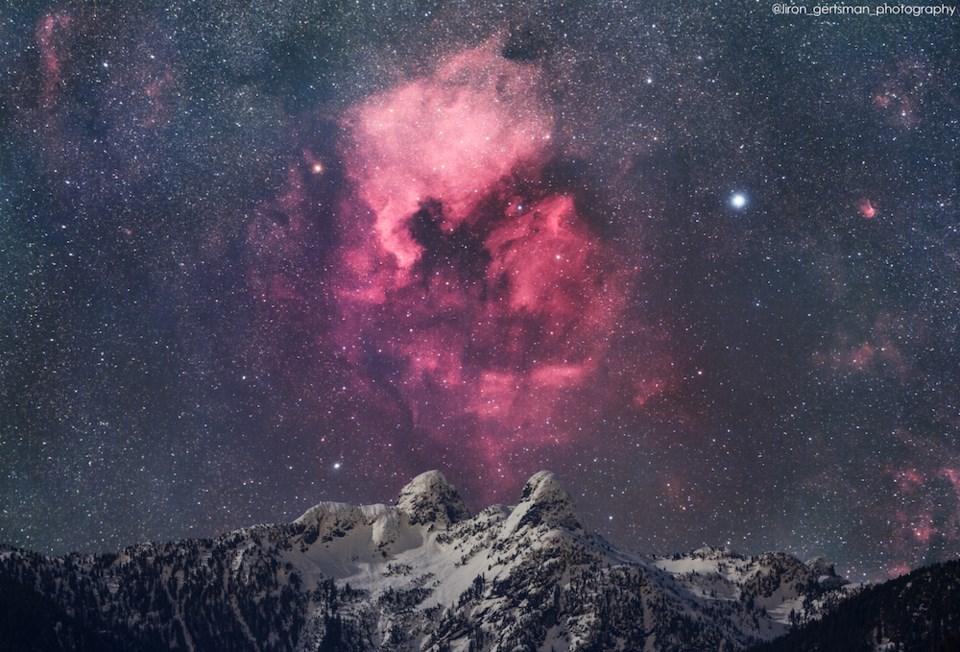A Vancouver astrophotographer is sharing a remarkable image of two nebulae glowing vibrantly above The Lions--known as the Two Sisters or Ch'ich'iyúy Elxwíkn, in the Squamish language.
The jaw-dropping snap features the North America and Pelican Nebulae beaming above the mountain peaks, in several shades of pink and red.
Liron Gertsman, a 20-year-old astrophotographer and astronomy enthusiast, tells Vancouver Is Awesome in a phone interview that the pandemic provides the ideal opportunity to stargaze. Not only is the activity safe, but long winter nights allow us ample opportunity to enjoy the profound beauty of stars and celestial phenomena.
For this image, he says, "I believe it's one of the most ambitious photographs I've ever taken, offering a unique perspective on a familiar Vancouver sight that people will be interested in seeing."
Gertsman explains that the photo took a considerable amount of planning, long exposure stacking techniques, and a camera modified to see further into the red light spectrum.
"I first imagined this photo a few months ago. While running virtual simulations on my computer, I was astonished to see that the North America Nebula, a huge cloud of gas over 2200 light-years from Earth, would align perfectly with The Lions, if I was in the right place at the right time," Gertsman notes.
"However, I would have to photograph from a heavily light-polluted area (Bortle 7). So, I was not convinced the image I was seeking would even be possible."
A rare clear night
In addition to heavy light pollution, Gertsman adds that Vancouver affords few clear nights during the winter. As such, he had to wait a few months for ideal conditions. While there was a 62 per cent full moon on Jan. 21, he says he was provided a rare clear night.
"I waited in the cold for three-and-a-half hours, gathering long exposure data on the nebula as it moved across the sky, until it was sitting directly above The Lions," he explains.
Gertsman's final image includes two hours of exposure time, taken from the same spot without movement of his tripod.
"I used a full-spectrum modified Canon 6D and a Canon 100-400mm lens at 200mm, mounted on a SkyWatcher star tracker," he notes.
"I used three filters: first, one that allows visible light to pass through, but extends further than normal to the 656nm H-alpha wavelength emitted by nebulae. This data was important for gathering accurate colour. Second, I used an H-alpha filter, which selectively allows the 656nm wavelength of the nebula through while blocking out most moonlight and light pollution. Finally, I used a normal visible light filter, to gather natural colours for the foreground. These images were combined, stacked, and stretched in post-processing to create this final image."
'Once-in-a-lifetime' photo of rare comet and Northern Lights in B.C.
In July 2020, Gertsman shared another remarkable image of a rare comet and Aurora Borealis at Harrison Lake.
The Neowise comet, discovered in March by NASA’s Neowise infrared space telescope, reached its closest point to the sun on July 3, which caused the “frozen ice ball” to heat up and burn gas and dust off its surface.
Back then, Gertsman told V.I.A. that he had never had the opportunity to shoot a comet before. The last comet visible from the northern hemisphere that was comparable to Neowise was Comet Hale–Bopp in 1997, which was before he was born.
Follow Gertsman on Instagram or check out his photography on his website.




